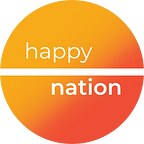Real success tip #2: Conditioned emotions
Did you know that happiness is trainable?
Yes. That is not a belief. That is more than a statement. That is a fact. Sciences proves it.
Happiness, a mosaic of emotions and hormones forming a state of flow that can be attained by focusing on mental, social and physical activities that give us — our bodies and minds — happy nutrients.
Happiness doesn’t always just happen, one must consciously take steps toward it.
While the physical level consists of nutrition and physical exercise and the social level of spending time with others, giving and sharing, the mental level comprises meditation and positive thinking. Indeed, all are interlinked and all are trainable.
Meditation and positive thinking help us understand and focus on what does us good rather than bad, being optimistic and open-minded.
To some people, it comes naturally. To others, it requires continuous efforts to go from being a cup that is half-empty to half-full, while sport might already well be incorporated into their lives.
Just like some people are naturally flexible, others need to practice yoga for years before being able to hold the same postures. At first, working on your arm strength to hold a handstand might be tiresome, but it eventually becomes a habit, something that you do without thinking too much about, like brushing your teeth.
Well, the same goes with our emotions!
Scientifically, learned behavior is called conditioned emotional response and was first theorized in Some quantitative properties of anxiety by B.F. Skinner and W. K. Estes in 1941 following the logic of pavlovian conditioning.
When an organism is exposed to a certain stimulus that then leads to a biological reaction — that may be saliva in the Pavlovian experiment with dogs, or emotions felt by individuals — a connection is made.
This connection is learned and then enables the individual to respond to the stimulus with an emotional response without going through an intermediary stage.
Positive emotions, when often exercised may become a conditioned response under defined conditions.
When something unfortunate happens, the first reaction may be to complain and see the negative effects of it. It might make you anxious, angry or depressed: emotions that then also negatively affect your or others’ behavior as well as your performance.
If you were to try and put it into perspective, understand what happened, learn from it and see the positive effects, you will be more relaxed and joyful. This in turn positively affects your actions and your productivity.
If you learn to think positively, it becomes your conditioned response and you tend to feel more positive feelings, even in bad situations, without having to put much effort into it. But of course, this takes practice over a longer period of time.
Pavlovian conditioning and happy thoughts
Have you ever felt a weirdly negative feeling toward someone you just met without knowing why? Yes? We all have…This could be why:
Let’s say that during your childhood you once had this teacher, Mr. so-and-so who had a hooked nose. This teacher was not a good pedagogue, didn’t explain things well and on top of that, was always grumpy and harsh on his students.
He was not very liked. Everyone was scared of him, including you.
Now, as an adult, this memory is deeply buried in your mind.
But, the story doesn’t stop there. Without realizing it, you developed a conditioned response to a stimulus: the hooked nose!
Decades later, when you decide to start the day with fresh bakeries and go to your local bakery, you sometimes get a weirdly negative feeling when the baker with the hooked nose serves you…There’s something you don’t like about him, although he’s always been nice to you. This is where your unconscious tricks you: your mind remembers the connection of negative emotions with hooked noses.
The baker triggered emotions that were ingrained in you by your teacher.
If you had associated feelings of compassion and sympathy with your teacher instead of dislike and fear, this would have changed the way you’ve felt about the baker. The first step is noticing this connection and then consciously work on breaking it (hooked nose = negative emotions).
This is to be applied to anything. Instead of thinking that rain ruins a good day outside, teach yourself to appreciate it, you would definitely feel better when rain forces you to change your plans! It’s a good occasion to plunge yourself into that old book that you always wanted to read!
If you teach yourself to think positively, it will become your conditioned response, that is, it will become a new habit (it’s never too late to learn a new habit!) and you will learn to feel positive emotions in new situations!
Teach yourself to associate problems with the opportunity to improve and grow instead of fear and anxiety, and you will learn to like challenges and approach problems with a more relaxed attitude.
You can find tips on how to think positively here.
Because every little step that you achieve today — big or small — matters. Doesn’t everyone deserve to be happy and successful? You hold it all in your hand. You can make a difference with every action you take.
Join our mission … let’s make the world a happier place!
